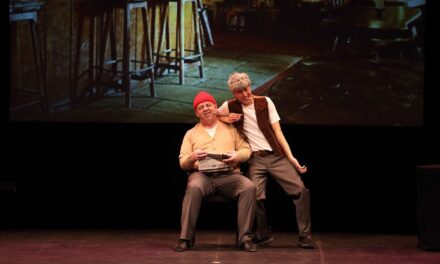An earlier production of Coppélia by the Russian State Ballet of Siberia – photo supplied by Norwich Theatre Royal
Coppélia
Every visit to Norwich by the Russian State Ballet of Siberia is eagerly anticipated and plays to packed houses at the Theatre Royal. Thursday night’s production of the gentle classic Coppélia was no exception.
Léo Delibes music for Coppélia is amongst the most delicate and delightful of ballet scores and it enhances a simple romantic tale. Set in Nineteenth Century Galicia the story is straightforward: boy has already met girl, they are in love and happy with each other but the boy gets distracted by the toy-maker’s dainty puppet (Coppélia) who is disturbingly life like and apparently can be animated into dance. The boy, Franz, is full of boyish tricks and games so the girl, Swanilda, decides to play a trick on him when she discovers the doll in the toymaker’s home. She takes the place and costume of the doll and dances before Franz, before being caught by the Toymaker Dr Coppelius. He is overjoyed that his ‘creation’ can dance so beautifully, until Swanilda throws off her disguise and escapes with Franz. Reassured that the doll is not real she forgives Franz and they recommence their tryst.
The final scene shows the lovers at their wedding where Dr Coppelius brings along Coppélia to show that his doll really can come alive and dance delightfully.
This is a delicate, pretty and traditional ballet and the highly skilled Siberian company have crafted a ballet to take round the world. They have not taken risks or tried to challenge the tradition, but rather chosen to present a light and unthreatening tale in a pretty and elegant manner. The Galician location gives the designers an opportunity for brightly coloured and beautifully presented costumes, the whole production is a riot of bright colours against pastel backgrounds. This is a ballet to stretch the talents of the corps and allow them to dazzle with their skills with many set pieces allowing all the principals to show off to a warm and enthusiastic audience. The second act in particular fits a series of spectacular dances into the appropriate setting of a happy wedding, with the dance by the ‘puppet’ Coppélia (Elena Lapina) being just one highlight.
The loving couple are played by the rather chunky George Bolsunovskiy as Franz and Ekaterina Bulgutova as Swanilda. They are both capable and energetic dancers, although I felt that Ekaterina seemed more relaxed in her solo dances which drew warm applause. Alexander Kuimov as the toymaker Dr Coppelius followed a rather camp first entry onto the stage with a dexterous and comedic performance, coming into his own while chasing Franz and Swanilda (masquerading as Coppélia) around his toy workshop.
For those who are unsure about ballet or find the art form hard to understand this performance is the perfect introduction, with delightful music and a captivating rendition from start to end. The story is easily understood and followed and the well crafted gestures and expressions enhance the enjoyment. A beautiful production.
La Fille Mal Gardée
For their second night in Norwich the Russian State Ballet of Siberia tackled ‘La Fille Mal Gardée’. With a heartier score than Coppélia this ballet, scored by Peter Ludwig Hertel, is another traditional crowd pleaser, first produced in France in 1789.
Once again a troubled romance is at the heart of this tale, this time between Lise, the lively daughter of the Widow Simone, and local young farmer Colas. They fall for each other early in the performance and spend happy times flirting with each other amongst their friends and neighbours. But the Widow Simone, brought to life in a pantomime dame fashion by Alexey Balva, has plans to marry her daughter to local vineyard squire Thomas’s son Alain, a hapless young man with carrot-red hair who just likes chasing butterflies. Much of Act One features the slapstick chasing around the stage of Simone trying to split up the young lovers, who are too quick and artful for her.
The Village Notary is summoned to confirm the marriage but Colas’s young friends get him drunk and Colas slips into the Notary’s costume and into Simone’s house where he catches up once more with Lise, and together they dance and get closer to each other.
When the Widow returns to the house hoping to cement the bond of her daughter to Alain she realises what is happening after the young couple are revealed together. Thomas tears up the marriage contract and after some remonstration Simone finally concedes to the wedding of Lise and Colas.
The final scene of the ballet, just as with Coppélia, sees the young couple celebrating their wedding with a series of spectacular dances by each and both of the young lovers and by all their young friends. There is even a clog dance by the Widow Simone, to the astonishment of all present, possibly including dancer Alexey Balva himself as he seemed a little unsure of his clog skills. He should not worry, over all Alexey has a dominant presence in the ballet and strikes the right balance as a cross dressed character who does not overplay the role, but allows the audience to enjoy the humour implicit in the casting.
Dmitriy Diachkov as Colas is a convincing and handsome young lover, while Elena Svinko as his partner Lise is a confident and delightful performer who dances beautifully while giving Lise a rounded and believable character as a spirited young girl finding love for the first time.
Denis Pogorelyy deserves a special mention for taking the difficult role of Alain, the hapless son of the toff Thomas (Maxim Dashidondokov) and making it rather special. Acting the fool with a carrot coloured wig, pink pantaloons and a yellow butterfly net is never going to be easy, but he takes the audience from possible derision to empathy with his pathos and good physical comedy.
The Russian State Ballet of Siberia are at Norwich Theatre Royal until Saturday, with Swan Lake as their final Norwich show before continuing their long tour. They come across as a young and energetic company and whilst occasionally not technically perfect they really engage with their audiences and the non-principal corps de ballet are very good and skilled at the balance between showing their own skills while highlighting the principal dancers. They fill theatres across the globe, with good reason. This is well presented ballet that everyone can watch, enjoy and remember with a smile.
©Julian Swainson





Recent Comments